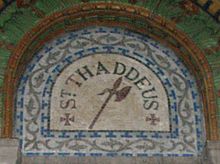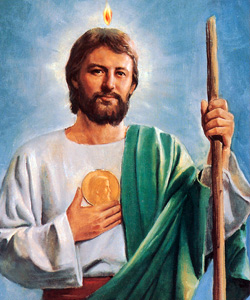St. Jude, Patron Saint of Hopeless Causes:
Posted by SociusNov 1
Last Sunday, 28th October, was the Feast Day of SS. Simon and Jude.
 |
Jude, the Apostle, by Anthonis van Dyck
I think that, throughout the faithful of the Catholic Church, St. Jude is very well known as the ‘patron saint of lost causes’ – a wonderful helper to those who resort to him, and seek his help, when all else appears to be hopeless. However, I wonder what sort of proportion would be aware of just why he is famous for helping those ‘at the end of their tether’. In my own case, I am not sure that I could have answered this question, correctly, without first having done some research into his life.
The origin of this aspect of this great saint’s patronage comes from a letter he wrote – the General Epistle of Jude, part of the New Testament that was addressed to the Churches of the East – especially the Jewish converts. Ultimately, it was directed against the heresies that were seen to be arising at that time. In his letter, he points out to the faithful that they should keep the faith, persevering in the environment of harsh and difficult circumstances, just as their forefathers had done before them.
But, who was Jude? Though little is known about his life from the gospels, he was one of Jesus’ Twelve Apostles and was variously known as Jude, Jude Thaddeus, Jude of James, (no doubt because he was the brother of St. James the Less), Judas Thaddeus, (sometimes referred to as Lebbaeus). Jude and Judas were variations of the name ‘Judah’. However, and although the naming culture of those days seems to make little or no distinction between ‘Jude’ and ‘Judas’, clearly he is to be distinguished from Judas Iscariot, the Apostle who was later to betray Jesus. It is thought that he was a cousin of Jesus, in that his Mother, also called Mary, was sister to Mary, the Mother of Jesus.
Jude (or Judas) is mentioned, at most, just three times in the New Testament. He is listed as one of the Twelve, at Luke 6:16 “And Judas the brother of James, and Judas Iscariot, which also was the traitor.” In Acts 1:13, after the Resurrection, he is listed as one of those who resorted to the Upper Room, and again he is named as Judas, the brother of James. There is one further mention, and this occurs in John 14:22, wherein it is said: “Judas saith unto him, not Iscariot, Lord, how is it that thou wilt manifest thyself unto us, and not to the world?”
After the Death and Resurrection of Jesus, it is thought that St. Jude travelled throughout Judea, Samaria,, Idumaea, Syria, Mesopotamia, Libya, and Persia, preaching and converting many to Christianity. With Bartholomew, it is believed the two were traditionally the first to bring Christianity to Armenia. They are venerated still as patron saints of the Armenian Apostolic Church.
 |
Mosaic Commemorating St. Jude’s Execution, St. Francis de Sales Catholic Church, Philadelphia
Armenian tradition also has it that he was martyred, by being beheaded, with St. Simon – the two are very often connected – around 65 AD, in Beirut, then part of the Roman province of Syria, and at some point after his execution, his body was brought to Rome and placed in a crypt in St. Peter’s Basilica; his remains are venerated by many of his devotees to this day.
 |
St. Jude is often shown dressed in green and white Biblical-era clothing, for he was one of the Disciples of Jesus; at the same time, he is usually pictured wearing, or holding, a golden metal image of Jesus, since legend has it that Jesus had been asked by the King of Edessa to cure him of leprosy, and had sent an artist to bring back to him an image of Our Lord. Jesus, impressed with this show of faith, had taken a towel, and had held it to his own face, so that his own image was left imprinted thereon, and had given this to St. Jude to take back to the King. At this the King was cured; he converted to Christianity, along with many of his subjects. St. Jude is also sometimes shown with a small flame atop his head, this to represent the fact that he was present when the Holy Spirit came down on the Apostles, confirming them at Pentecost, with tongues of fire.
As to the devotional followings, it is said that Jesus, himself, inspired devotion to St. Jude when he directed St. Bridget of Sweden to turn to St. Jude with great faith and confidence. In accordance with his surname, Thaddeus (which means generous, courageous, kind), Our Lord said, “He will show himself most willing to give help.” The renowned St. Bernard of Clairvaux, who died in 1153 and who was declared a Doctor of the Church in 1830, is reputed to have had a strong personal dedication to St. Jude.
Today, millions of people around the world turn to St. Jude, patron saint of seemingly impossible or difficult causes, when they feel most helpless and alone. St. Jude has proven to be a true friend and a beacon of hope to those who call on him. It is customary to make a vow that if he helps when called upon, one will publish a notice of thanks in the newspaper, traditionally most often in ‘The Times’. Thus, the personal columns often carry the short word of thanks: “Thank you, St. Jude”, or “Thanks to St. Jude for help in answer to my prayers”, each of these being evidence of the continuing and growing devotion to this great saint. Today, such messages of prayers and thanks can be seen posted into the Catholic prayer websites. His feast day (together with St. Simon) is held annually on 28 October.
Form of Prayer to St. Jude:
O most holy apostle, Saint Jude, faithful servant and friend of Jesus, the Church honours and invokes thee universally, as the patron of hopeless cases, and of things almost despaired of. Pray for me, who am so miserable. Make use, I implore thee, of that particular privilege accorded to thee, to bring visible and speedy help where help was almost despaired of. Come to mine assistance in this great need, that I may receive the consolation and succour of Heaven in all my necessities, tribulations, and sufferings, particularly (here make your request) and that I may praise God with thee and all the elect throughout eternity. I promise thee, O blessed Jude, to be ever mindful of this great favour, to always honour thee as my special and powerful patron, and to gratefully encourage devotion to thee. Amen.
Socius
The blog in its orignal formatting can be seen at the main blog site.

No comments